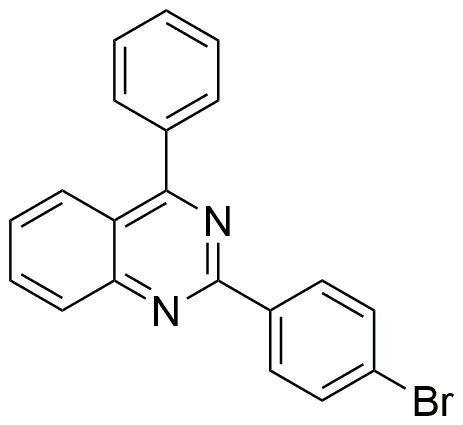2-(4-Bromophenyl)-4-phenylquinazoline is widely utilized in research focused on:
- Pharmaceutical Development: This compound serves as a key intermediate in the synthesis of potential anti-cancer agents, providing researchers with a pathway to develop targeted therapies.
- Material Science: Its unique structure allows for applications in creating advanced materials, particularly in organic electronics, where it can enhance the performance of organic semiconductors.
- Biological Research: The compound is used in studies investigating cell signaling pathways, helping scientists understand disease mechanisms and develop new treatment strategies.
- Fluorescent Probes: It can be utilized in the development of fluorescent probes for imaging applications, aiding researchers in visualizing cellular processes in real-time.
- Drug Design: The compound's structural properties make it a valuable scaffold for designing new drugs, particularly in the search for novel therapeutics against various diseases.
General Information
Properties
Safety and Regulations
Applications
2-(4-Bromophenyl)-4-phenylquinazoline is widely utilized in research focused on:
- Pharmaceutical Development: This compound serves as a key intermediate in the synthesis of potential anti-cancer agents, providing researchers with a pathway to develop targeted therapies.
- Material Science: Its unique structure allows for applications in creating advanced materials, particularly in organic electronics, where it can enhance the performance of organic semiconductors.
- Biological Research: The compound is used in studies investigating cell signaling pathways, helping scientists understand disease mechanisms and develop new treatment strategies.
- Fluorescent Probes: It can be utilized in the development of fluorescent probes for imaging applications, aiding researchers in visualizing cellular processes in real-time.
- Drug Design: The compound's structural properties make it a valuable scaffold for designing new drugs, particularly in the search for novel therapeutics against various diseases.
Documents
Safety Data Sheets (SDS)
The SDS provides comprehensive safety information on handling, storage, and disposal of the product.
Product Specification (PS)
The PS provides a comprehensive breakdown of the product’s properties, including chemical composition, physical state, purity, and storage requirements. It also details acceptable quality ranges and the product's intended applications.
Certificates of Analysis (COA)
Search for Certificates of Analysis (COA) by entering the products Lot Number. Lot and Batch Numbers can be found on a product’s label following the words ‘Lot’ or ‘Batch’.
Numéro de catalogue
Numéro de lot/série
Certificates Of Origin (COO)
This COO confirms the country where the product was manufactured, and also details the materials and components used in it and whether it is derived from natural, synthetic, or other specific sources. This certificate may be required for customs, trade, and regulatory compliance.
Numéro de catalogue
Numéro de lot/série
Safety Data Sheets (SDS)
The SDS provides comprehensive safety information on handling, storage, and disposal of the product.
DownloadProduct Specification (PS)
The PS provides a comprehensive breakdown of the product’s properties, including chemical composition, physical state, purity, and storage requirements. It also details acceptable quality ranges and the product's intended applications.
DownloadCertificates of Analysis (COA)
Search for Certificates of Analysis (COA) by entering the products Lot Number. Lot and Batch Numbers can be found on a product’s label following the words ‘Lot’ or ‘Batch’.
Numéro de catalogue
Numéro de lot/série
Certificates Of Origin (COO)
This COO confirms the country where the product was manufactured, and also details the materials and components used in it and whether it is derived from natural, synthetic, or other specific sources. This certificate may be required for customs, trade, and regulatory compliance.


